March in Delaware
Latest changes: 2009-07-16: re-organized by state / 2010-09-15: renamedNOTE: These W3R campsite-and-trail maps were developed
during the 2000-2005 National Park Service study of significance,
feasibility, and environmental impact.
The orientation is tilted; north is about 45-degrees left of straight up.

The Delaware portion of the W3R campsite map
|
You may imagine the dramatic scene for folks who lived near the route
as the allied forces, now combined in a single column of march,
passed through Delaware. The roughly 4,500 troops of the French Army formed
about 60 companies of 72 men and officers. They moved through Delaware
in two brigades of roughly 30 companies each. The columns were spaced a day's march
apart (16 miles) so that they could camp in the same site as the previous day's
column had used. A company of 64 men (and eight officers) marching
four abreast and separated by 6 feet would take up about 100 feet,
and if the companies were spaced 100 feet apart the 31 companies
would stretch out for 6,200 feet, a bit over a mile.
At a pace of three miles per hour this column would take nearly half an hour to pass by, at about one company per 50 seconds. The hussars and mounted officers would provide points of special interest, while the baggage wagons and oxen for each column would move as separate and slower units. Quartermasters and purchasing agents would bargain with local farmers and merchants to buy food and other wares and provide pasturage for the hundreds of horses and cattle accompanying the army. The Continental army often paid with IOUs, but the French Army paid in silver. While the French Army was mostly made up of subjects of the King of France, there were from other parts of Europe soldiers who spoke German, Polish, and English. If each company occupied a campsite 16 yards square the brigade would require a campsite area roughly 90 yards square. This should be near a stream with sufficient flow to provide for drinking, cooking, and washing for 2,500 soldiers. The baggage train, horses, and cattle would be distributed among local farms. Setting up and taking down such a camp each day was a mighty undertaking.
The information on this page was taken from the 400-page report
on "The Washington-Rochambeau Route in Delaware, 1781-1783",
by Dr. Robert Selig (State of Delaware, 2003). It is available to read or to download at
|
What Allied Units went South to Yorktown in 1781Six different groups passed through Delaware. The W3R auto tour route in Delaware follows the Continental Army route (#2 below).#1 -- On Sept 2 (see pp 78-80 of Selig's report on DE) small ships carrying guard units from the Continental Army and clothing, ammunition, tools, and other heavy supplies followed the water route: down the Delaware River, up the Christina River past Wilmington and Newport to Christiana, arriving about midnight. The troops were comprised of about 520 men: 200 from Lamb's Second Continental Artillery, 50 from the Sappers and Miners, and 270 from Hazen's Canadian Regiment. The units unloaded the boats and transported the supplies to Elk Landing during the three days before the boat carriages arrived (see 5 below). #2 -- On Sept 4 (pp 73-78) the main units of the Continental Army followed the King's Highway (now called Philadelphia Pike, Business Route 13, and Market St as you near Wilmington). This group was comprised of about 1,500 men, about 25 women and about 500 horses and cattle. The soldiers and officers were 360 from the First RI, 390 from the First NY, 380 from Scammel's Light Infantry, 340 from the First and Second NJ, plus about 50 artificers. They forded the Brandywine River and continued down King St. Here they passed the Wilmington Academy (where the Grand Opera House now stands). In 1782-83 some 550 soldiers from Lauzun's Legion were housed here. Half were hussars (light cavalry) and the stables were behind it, where the park is today. They turned right on 4th St. and right on 4th to Maryland Ave, following this to Richardson's Mill, where they camped next to Mill Creek on Sept 4. In 1776 Caesar Rodney had ridden north along this route on the way from Dover to Philadelphia to cast the vote that allowed Delaware to support the Declaration of Independence and thus make the vote (counted by state) unanimous. On Sept 5 the Continentals continued through Newport on Rt 4 to Stanton (where Rt 7 joins Rt 4) and then followed the Stanton-Christiana Road (now Rt 7) to Christiana. From here they continued straight on Old Baltimore Pike, passing over Cooch's Bridge, the site of the only battle fought in Delaware during the Revolution. On September 3, 1777, the first truly national Continental unit, made up of 700 experienced troops drawn from the Continental Regiments present and 300 of the Delaware militia conducted an extended harassing action against a column of 9,000 Hessian and British forces advancing inland from Head of Elk (present-day Elkton MD). The British burned down Thomas Cooch's barn, and Gen. Cornwallis used Cooch's home as his headquarters for several days before leaving for the battle of the Brandywine in PA. #3 -- On Sept 6th (pp 83-87) the First Brigade of the French Army marched 11.5 miles to Wilmington, following the King's Highway (now called Philadelphia Pike, Business Route 13, and Market St as you near Wilmington). Crossing the bridge at Brandywine Village, they branched right (by a diagonal road that no longer exists) to West Street to Fifth Street and then right to Pasture Street (now Washington Street) and left to Front Street (now Lancaster Pike) where they camped in the area between Justison and Adams Streets. This brigade consisted of over 2,500 men and officers (and perhaps 1,000 horses and cattle): 850 from the Bourbonnais, 900 from the Royal Deux-Ponts, 550 from Lauzun's Legion, 200 from its artillery, and the baggage train. On September 7 they marched on to Elkton MD. The hussars of Lauzun's Legion camped a mile farther down Maryland Ave. next to Richardson's Mill on Mill Creek (where the Continentals had camped Sept 4). 
"Lauzun's Legion Camped at Richardson's Mill in Delaware" by  David R. Wagner David R. Wagner
(used with the artist's permission) Note: Lauzun's Legion spent the winter of 1782-3 in Wilmington at the Wilmington Academy (on the site where the Grand Opera House now stands on Market Street between 7th and 8th). This garrison was intended to defend against any new British attack on Philadelphia. About sixty men either mustered out of service or deserted here and did not return to Europe. #4 -- Also on Sept 6 (pp 76-77) Generals Washington and Rochambeau and their staffs (70 for Washington) came down Philadelphia Pike and stayed in Wilmington. On Sept 7 they continued on to Maryland the next day via Newport, Christiana and Elkton. #5 -- Also on Sept 6 (pp 80-82) the Second NY with 420 men and officers brought some 15 special carriages designed to transport boats to Christiana -- some carriage went in the 30 flat-boats they had and some went by land. RDN's guess is half went by water (200) and half by land (220). They spent Sept 7 and 8 transporting supplies from Christiana to Elkton, then marched to Elkton MD on the 9th. Joining their ranks (and led by Capt. Prew Bennett) were 85 fresh Delaware Continentals who had been recruited and trained to fill the depleted ranks of the Delaware Regiment (now in South Carolina). Alter they particiated in the siege at Yorktown they continued south to fulfill join the Delaware Regiment. #6 -- On Sept 7th (p 87) the Second Brigade of the French Army marched 15.5 miles to Newport. Selig does not detail the route around Wilmington, but they probably followed the First Brigade's route. This brigade consisted of about 2,000 men and officers (and perhaps 1,000 horses and cattle): 950 from the Soissonais, 850 from the Santonge, 200 from their artillery, and the baggage train. They camped in the low area where the Red Clay Creek passes under Rt 4. [Both brigades of the French army camped here on their return from Yorktown in 1782.] On Sept 8 they marched on to Elkton MD. |
